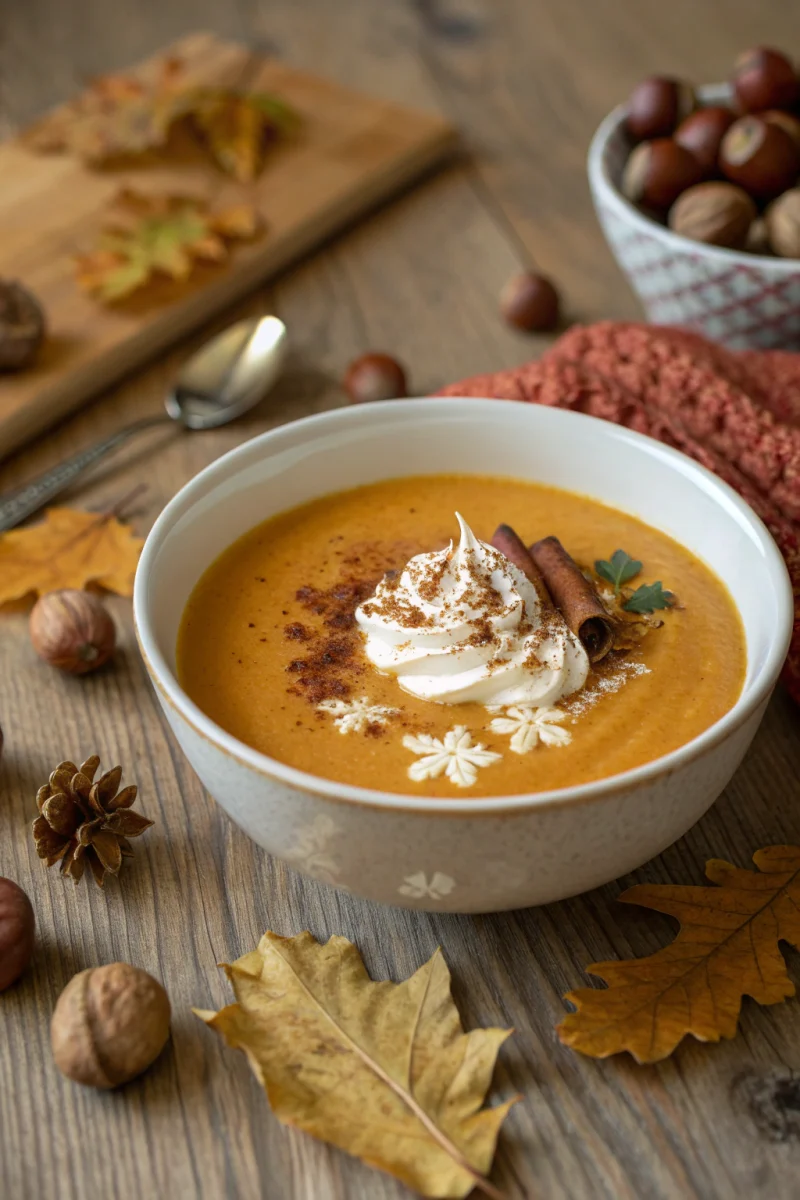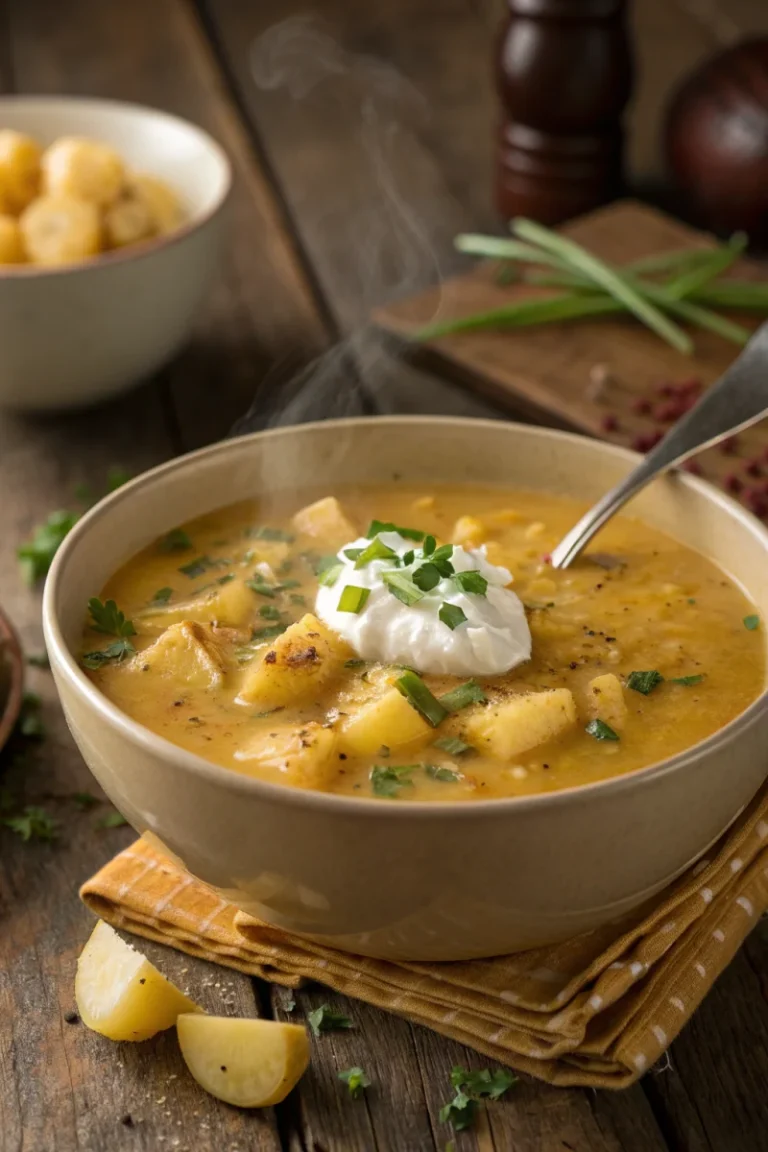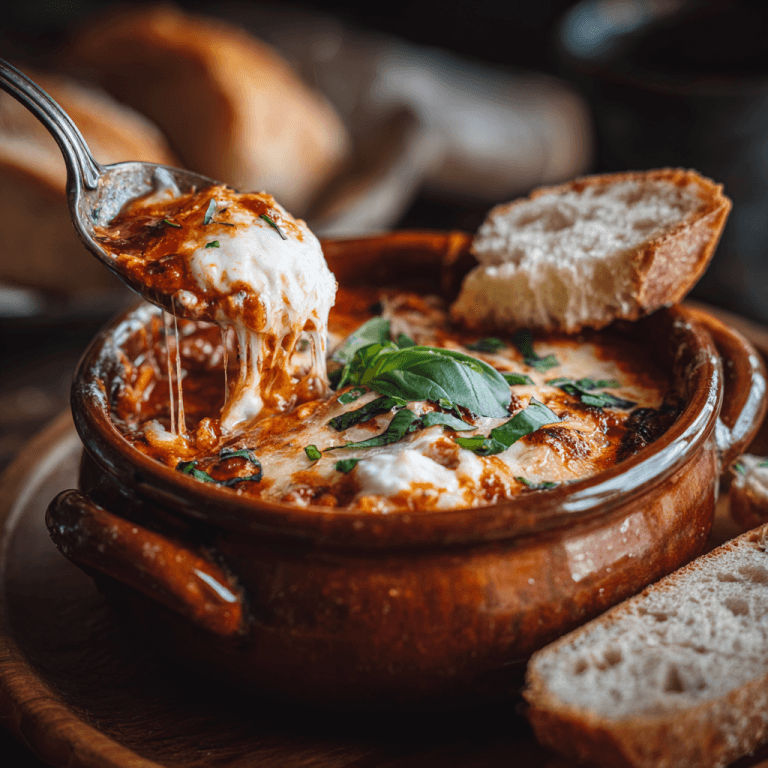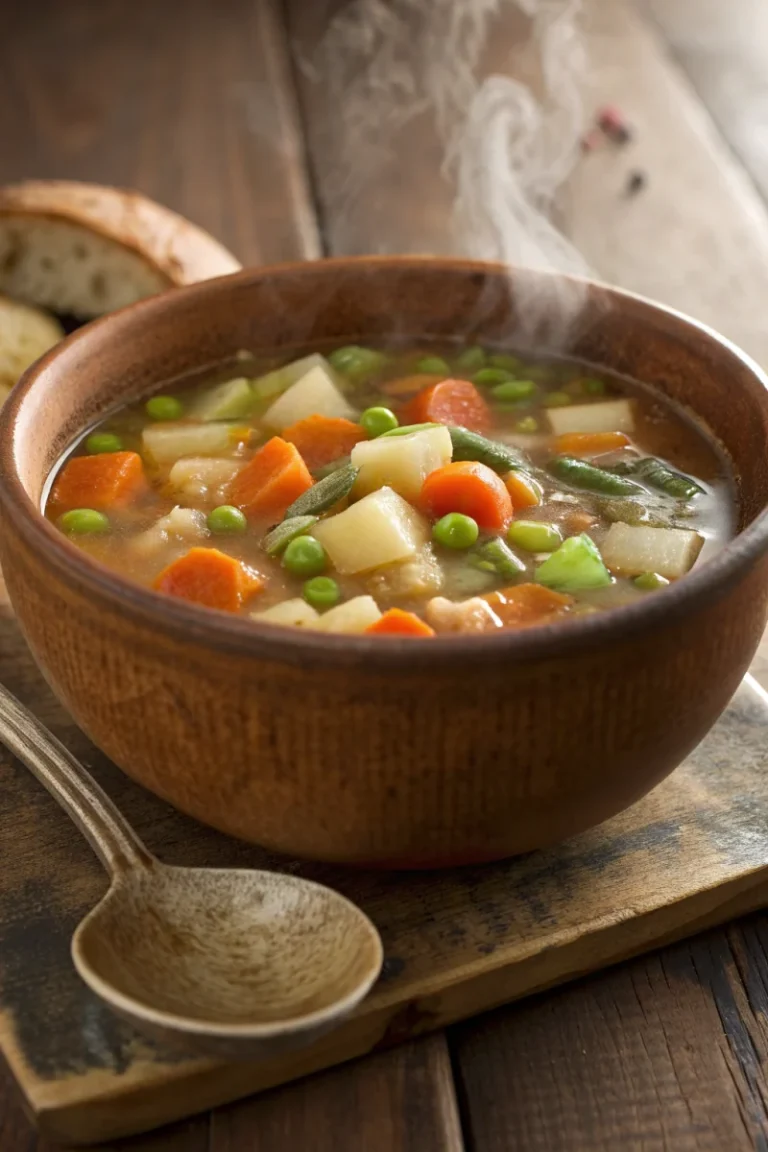Easy Creamy Pumpkin Soup Recipe: Cozy Fall Comfort in Under 30 Minutes
WFall Soup Recipes — The Ultimate Guide to Hearty and Wholesome Comfort
Fall Soup Recipes combines heartiness, warmth, and nutrition in one bowl. This comprehensive guide reveals how to make the perfect fall soup — comforting, wholesome, and deeply flavorful, crafted with chef-level technique and family-friendly ease. Embrace the seasonal bounty and transform simple ingredients into a warming masterpiece that satisfies the soul.
Why Fall Soup Recipes Matters in Winter
As the days grow shorter and the air turns crisp, our bodies naturally crave comforting, warm foods. Fall Soup Recipes are more than just a meal; they are a ritual, a connection to the season’s harvest, and a powerful source of hydration and essential nutrients. During colder months, maintaining warmth and supporting immune health becomes paramount. A well-crafted fall soup offers both, blending nutrient-rich ingredients like root vegetables, hearty grains, and lean proteins with slow-simmered depth. From rustic, chunky vegetable broths to velvety, creamy textures, it’s a versatile dish that soothes the senses, strengthens the body, and provides a delightful culinary experience. The act of simmering a pot of soup fills the home with an inviting aroma, setting a cozy atmosphere that is perfect for gathering with loved ones. Moreover, the slow cooking process allows flavors to meld and deepen, transforming humble ingredients into something extraordinary. This makes fall soups an ideal choice for both everyday meals and special occasions, providing sustained energy and satiety throughout the chilly season.
Core Ingredients for Essential Fall Soup Recipes
Crafting a truly remarkable fall soup begins with selecting the right core ingredients. While versatility is a hallmark of soup making, certain staples lay the foundation for a comforting and nutritious bowl. Here’s a breakdown of the essential components:
- 1 tbsp extra virgin olive oil: The starting point for sautéing, adding a subtle fruitiness and healthy fats.
- 1 large yellow onion, finely chopped: The aromatic backbone of almost any savory dish, caramelizing to add sweetness and depth.
- 2-3 cloves garlic, minced: Pungent and essential, garlic infuses the soup with its distinctive flavor and offers health benefits.
- 2 medium carrots, diced: Adds natural sweetness, vibrant color, and a good source of beta-carotene to your Fall Soup Recipes.
- 2 stalks celery, sliced: Provides a subtle savory note and essential texture, contributing to the classic mirepoix base.
- 4 cups high-quality vegetable or chicken broth: The liquid foundation. Opt for low-sodium to control seasoning.
- 1 cup cooked barley or brown rice: Adds heartiness, fiber, and makes the soup a more complete meal.
- Salt, freshly ground black pepper, dried thyme, and one bay leaf to taste: These fundamental seasonings are crucial for building complex flavors. Thyme offers an earthy, peppery note, while a bay leaf provides a subtle, almost floral undertone that rounds out the savory profile.
- Optional but Recommended: A splash of apple cider vinegar or lemon juice at the end brightens all the flavors.
Step-by-Step Method for Perfect Fall Soup Recipes
Achieving a deeply flavorful fall soup doesn’t require complex techniques, but rather a methodical approach to building layers of taste. Follow these steps for an outstanding bowl every time:
Step 1 — Building Your Flavor Base (Mirepoix and Aromatics)
The foundation of any great soup begins with properly sautéed aromatics. In a large, heavy-bottomed pot or Dutch oven, heat the olive oil over medium heat. Add the finely chopped onion, diced carrots, and sliced celery. Sauté gently, stirring occasionally, for 8-10 minutes, or until the onions are translucent and softened, and the carrots and celery are slightly tender. This step, often called building a mirepoix, is critical because it allows the natural sugars in the vegetables to caramelize slightly, developing a deep, complex sweetness that will permeate the entire soup. Don’t rush this stage; patient sautéing is key to unlocking the full flavor potential. Once the vegetables are softened, add the minced garlic and cook for another minute until fragrant, being careful not to burn it (burned garlic turns bitter).

Step 2 — Infusing Depth (Broth and Spices)
Once your aromatics are beautifully fragrant, it’s time to introduce the liquid and seasonings that will give your Fall Soup Recipes its characteristic “fall” essence. Pour in the 4 cups of vegetable or chicken broth. Add the dried thyme, bay leaf, a generous pinch of salt, and a few grinds of black pepper. Stir everything together. Bring the soup to a gentle simmer over medium-high heat. Once simmering, reduce the heat to low, cover the pot, and let it cook for 25-30 minutes. This allows all the flavors to meld and deepen, and ensures the carrots become fully tender. During this simmering period, occasionally check the soup and give it a stir. If any foam or scum rises to the surface, gently skim it off with a spoon. This helps to keep your broth clear and clean-tasting. The longer you let it simmer gently, the more developed the flavors will become, so if you have extra time, a slightly longer simmer at a very low heat can further enhance the soup’s complexity.
Step 3 — Adding Grains and Finishing Touches
The final stage brings everything together and adds substance to your delicious Fall Soup Recipes. Stir in the 1 cup of cooked barley or rice. If adding any other rapid-cooking vegetables like spinach or frozen peas, now is the time to incorporate them, allowing them to cook for just a few minutes until tender-crisp. Continue to simmer for another 5-10 minutes to allow the grains to absorb some of the flavorful broth and heat through. Before serving, remove the bay leaf. Taste the soup and adjust the seasonings as needed. This is a crucial step; a soup can always benefit from a final pinch of salt or pepper, or perhaps a hint more thyme. Consider adding a squeeze of fresh lemon juice or a splash of apple cider vinegar at this point. The acidity magically brightens all the flavors, making the soup taste more vibrant and balanced. Serve your hot and comforting Fall Soup Recipes immediately, garnished perhaps with fresh parsley or chives, and enjoy the fruits of your labor.
Nutrition Facts (per serving)
Understanding the nutritional profile of your Fall Soup Recipes can help you appreciate its wholesome benefits. Based on the core ingredients, a single serving (approximately 1.5 cups) typically provides:
- Calories: Approximately 230-280 calories (depending on grain choice and exact broth used).
- Protein: 9-12g.
- Carbohydrates: 32-40g, largely from vegetables and grains, providing sustained energy.
- Fat: 7-10g, primarily from healthy olive oil and naturally occurring fats in the broth.
- Fiber: 5-7g, excellent for digestive health and satiety, mainly from vegetables and whole grains.
- Sodium: 410-550mg (can be lower if using very low-sodium broth and controlling added salt).
- Vitamins and Minerals: Rich in Vitamin A (from carrots), Vitamin K (from celery), and B vitamins (from grains), along with essential minerals like potassium and magnesium.
This balanced nutritional profile makes Fall Soup Recipes an excellent choice for a hearty, health-conscious meal, offering sustained energy and essential micronutrients without being overly heavy. It’s a testament to how comforting food can also be incredibly good for you.
Healthy Variations and Customizations for Your Fall Soup Recipes
The beauty of Fall Soup Recipes lies in their adaptability. You can effortlessly transform this basic recipe into countless healthy variations, catering to different tastes, dietary needs, and what you have on hand. Here are some ideas:
- Boost Protein: Enhance the satiety and nutritional value by adding extra lean proteins. Stir in 1 cup of cooked lentils (brown or green are excellent) along with the grains, or add drained and rinsed chickpeas for a plant-based protein punch. For non-vegetarian options, shred leftover cooked chicken or turkey into the soup during the last 10 minutes of simmering. Cooked ground turkey or a spoonful of grass-fed beef can also be browned and added earlier in the process.
- Add More Greens: Incorporate nutrient-dense leafy greens for an extra boost of vitamins and antioxidants. Stir in 2 cups of chopped kale, spinach, or Swiss chard during the last 5-10 minutes of cooking, allowing them to wilt into the hot broth. The residual heat will cook them perfectly without overdoing it.
- Creamy (Dairy-Free) Version: For a velvety texture without dairy, transfer about one-third of the cooked soup (solids and liquid) to a blender. Blend until smooth, then stir the puréed mixture back into the pot. This naturally thickens the soup using the vegetables themselves. Alternatively, stir in 1/2 cup of full-fat unsweetened coconut milk or a plant-based unsweetened creamer (like cashew cream) at the very end.
- Spice It Up: Introduce warming spices for an extra layer of flavor and a touch of heat. A pinch of smoked paprika, chili powder, or a dash of cayenne pepper can add a wonderful kick. For an earthy, complex profile, consider using a touch of cumin or coriander, especially if you’re leaning towards a lentil-based variation.
- Root Vegetable Medley: Beyond carrots, swap in or add other seasonal root vegetables like diced parsnips, turnip, sweet potatoes, or butternut squash. These add different textures, colors, and a rich, earthy sweetness that truly captures the essence of fall. Add them earlier in the simmering process to ensure they cook through.
- Herbal Infusion: Experiment with different fresh herbs. While dried thyme is a staple, adding fresh rosemary, sage, or parsley towards the end of cooking can elevate the aroma and flavor significantly. Fresh dill also pairs wonderfully with earthy autumn vegetables.
- Grain Alternatives: If barley or rice aren’t your preference, consider other hearty grains. Farro, freekeh, or even small pasta shapes like ditalini or orzo can be cooked directly in the soup (add them according to package directions, usually 10-15 minutes before the soup is done). Alternatively, serve the soup over a scoop of couscous or mashed potatoes for a different texture.
These variations demonstrate how a single Fall Soup Recipes blueprint can lead to endless delicious possibilities, allowing you to enjoy a comforting and healthy meal that never gets boring.
Serving Suggestions for Hearty Fall Soup Recipes
A bowl of warm Fall Soup Recipes is satisfying on its own, but pairing it with the right accompaniments can elevate the entire meal. Consider these suggestions to complete your cozy fall evening:
- Crusty Whole-Grain Bread: A warm, crusty loaf of whole-grain bread is the quintessential companion for soup. Its texture provides a pleasant contrast, and it’s perfect for soaking up every last drop of that flavorful broth. Consider a sourdough or a rustic multi-grain boule.
- Garlic Herb Flatbread: For something a little more special, serve your soup with a side of homemade or store-bought Garlic Herb Flatbread. The aromatic garlic and fresh herbs complement the soup’s savory notes beautifully, offering a delightful chewiness.
- Simple Green Salad: A light, crisp green salad with a tangy vinaigrette offers a refreshing counterpoint to the richness of the soup. Use seasonal greens like mixed baby greens, arugula, or even finely chopped endive.
- Gourmet Grilled Cheese: Elevate the classic soup-and-sandwich combo. A grilled cheese made with artisanal bread and a sharper cheddar or Gruyère can be an incredibly decadent pairing.
- Roasted Vegetables: Serve alongside a platter of roasted seasonal vegetables such as Brussels sprouts, broccoli, or asparagus. Their caramelized edges and earthy flavors complement the soup particularly well.
- Honey Oat Energy Bites: For a delightful and healthy dessert or a post-meal treat, pair your soup with Honey Oat Energy Bites. These offer a touch of sweetness and sustained energy without being overly heavy.
- Freshly Grated Parmesan: A sprinkle of good quality Parmesan cheese (or a vegan alternative) adds a salty, umami kick and a visually appealing finish to many Fall Soup Recipes.
- Dollop of Yogurt or Sour Cream: For certain variations, especially those with root vegetables or a hint of spice, a dollop of plain Greek yogurt or sour cream (or a dairy-free alternative) can add a creamy tang and coolness.
Remember that presentation matters too! Serve your Fall Soup Recipes in beautiful bowls, perhaps with a sprig of fresh herbs as a garnish, to enhance the dining experience.
Common Mistakes to Avoid When Making Fall Soup Recipes
Even though Fall Soup Recipes seem straightforward, there are common pitfalls that can detract from an otherwise delicious outcome. Being aware of these can ensure your soup always turns out perfect:
- Boiling Instead of Simmering: One of the most frequent mistakes is cooking soup at a rolling boil. High heat can tough-up vegetables, break down delicate ingredients, and lead to a cloudy broth. Always aim for a gentle simmer, just a few bubbles breaking the surface, to allow flavors to meld gradually and maintain the integrity of your ingredients. This also helps to prevent excessive evaporation.
- Under-seasoning (or Seasoning Only at the End): Salt and pepper are flavor enhancers, not just additions. Seasoning in layers – a pinch with the aromatics, another with the broth, and a final adjustment at the end – builds depth. If you only season at the very end, the flavors can taste one-dimensional and unintegrated. Remember that the amount of salt needed will depend on your broth’s sodium content.
- Overcrowding the Pot: Whether it’s sautéing your aromatics or adding too many vegetables at once, overcrowding cools the pot down quickly, steaming rather than browning ingredients. This prevents proper caramelization and flavor development. Work in batches if necessary, especially when browning meat or sautéing large quantities of vegetables.
- Using Low-Quality Broth (or too little): The broth is the backbone of your Fall Soup Recipes. A weak, watery, or overly salty commercial broth can undo all your other efforts. Invest in good quality, low-sodium broth or, even better, use homemade stock. If your soup seems too thick, don’t be afraid to add a little more broth or water during the cooking process.
- Not Sautéing Aromatics Long Enough: Rushing the initial sauté of onions, carrots, and celery (the mirepoix) means missing out on the foundational sweetness and complexity they provide. These vegetables need time over medium heat to soften, release their sugars, and develop a golden hue.
- Overcooking Vegetables or Grains: Mushy vegetables or disintegrated grains are tell-tale signs of overcooking. Add grains according to their package directions, usually towards the end of the simmering process. Similarly, delicate vegetables like spinach or finely diced zucchini should only be added for the last few minutes of cooking.
- Forgetting About Acidity: A squeeze of fresh lemon juice, a splash of red wine vinegar, or a dash of apple cider vinegar at the very end can brighten and balance all the flavors in your Fall Soup Recipes, preventing it from tasting flat. It’s often the secret ingredient that makes a soup truly sing.
- Not Letting Flavors Mingle: While freshly cooked soup is delicious, many soups, especially vegetable and grain-based ones, taste even better the next day. This is because the ingredients have more time to infuse the broth and for all the flavors to deepen and harmonize. Consider making your Fall Soup Recipes a day in advance for optimal flavor.
By avoiding these common missteps, you’ll be well on your way to consistently crafting outstanding and comforting Fall Soup Recipes.
Storage Tips for Your Delicious Fall Soup Recipes
One of the many advantages of Fall Soup Recipes is how well they store, making them perfect for meal prep or enjoying leftovers. Proper storage ensures your soup remains flavorful and safe to eat:
- Cool Down Quickly: Before storing, allow the soup to cool down to room temperature for no more than 30-60 minutes. To speed this up, you can divide large batches into smaller containers or place the pot in an ice bath. Rapid cooling prevents bacteria from developing.
- Airtight Containers: Transfer the cooled soup into clean, airtight containers. Glass containers with tightly sealing lids are ideal as they don’t stain or absorb odors. Ensure there’s minimal air space at the top to reduce exposure to oxygen.
- Refrigeration: Stored in the refrigerator, your Fall Soup Recipes will remain fresh and delicious for up to 3-4 days. This makes it an excellent option for healthy lunches or quick dinners throughout the week.
- Freezing: Fall soups freeze exceptionally well, making them perfect for longer-term storage. You can freeze soup for up to 3 months. When freezing, consider using freezer-safe plastic containers, heavy-duty freezer bags (laid flat for efficient storage), or even individual portions in muffin tins (once frozen, pop them out and transfer to a freezer bag). Label with the date.
- Reheating: To reheat, gently warm the soup over medium-low heat on the stovetop. Avoid a rapid boil, which can degrade the texture of vegetables and grains. If reheating from frozen, you can either thaw overnight in the refrigerator or gently reheat from frozen on the stovetop, adding a splash of broth or water if it seems too thick. Microwave reheating is also an option for individual portions, stirring occasionally to ensure even heating. Always ensure the soup is steaming hot throughout before serving.
- Note on Creamy Soups: If your Fall Soup Recipes include dairy (like heavy cream or milk), it may separate slightly upon reheating or after freezing. This is usually just a cosmetic issue; a good stir will often re-emulsify it. Plant-based creamers tend to hold up a bit better.
With these storage tips, you can enjoy the wholesome goodness of your homemade Fall Soup Recipes long after it’s freshly cooked, without compromising on quality or flavor.
Advanced Techniques to Elevate Your Fall Soup Recipes
While the basic steps ensure a delicious soup, incorporating a few chef-level techniques can transform your Fall Soup Recipes into a truly gourmet experience:
- Roasting Vegetables for Depth: Instead of just sautéing your harder vegetables like carrots, parsnips, or even squash, try roasting them first. Toss diced vegetables with olive oil, salt, and pepper, then roast at 400°F (200°C) until tender and slightly caramelized. This deepens their sweetness and adds an incredible complexity to the broth when added to the pot.
- Deglazing the Pot: After sautéing aromatics and browning any meat if using, pour a splash of wine (dry white or red, depending on the soup) or a bit of vegetable broth into the hot pot. Scrape up all the flavorful browned bits from the bottom with a wooden spoon. This process, called deglazing, adds concentrated flavor and helps create a richer broth.
- Toasting Grains/Pasta: Before adding barley, rice, or small pasta shapes to the pot, briefly toast them in a dry pan or directly in the soup pot with a tiny bit of oil until fragrant and slightly golden. This enhances their nutty flavor and can improve their texture.
- Infusing Broth with Herb Bundles: Create a “sachet d’épices” or herb bundle by tying fresh thyme, parsley stems, bay leaves, and maybe a few black peppercorns in cheesecloth. This allows the herbs to infuse their flavor into the broth without leaving loose bits in the soup, and it’s easy to remove before serving.
- Finishing with Fresh Herbs and Acid: Always finish your Fall Soup Recipes with a generous scattering of fresh, vibrant herbs like parsley, chives, or dill. Their fresh, pungent flavors provide a beautiful contrast to the cooked ingredients. A final squeeze of fresh lemon juice or a dash of good quality vinegar (like apple cider vinegar or sherry vinegar) also brightens the soup significantly, making all the other flavors pop.
- Building a Roux for Thickening: If you desire a slightly thicker, richer consistency for your Fall Soup Recipes, you can start with a roux. After sautéing aromatics, sprinkle 1-2 tablespoons of flour over them, stir, and cook for 1-2 minutes to cook out the raw flour taste. Then gradually whisk in the broth. This creates a smooth, creamy base.
- Emulsifying with Butter or Cream: For a luxurious finish, especially in puréed soups, whisk in a knob of cold butter or a swirl of heavy cream (or plant-based alternative) right before serving. This adds richness and a silky mouthfeel.
- Charring for Smoky Notes: For heartier, vegetable-based Fall Soup Recipes, lightly char some of your onions, bell peppers, or even tomatoes directly over a gas flame or under a broiler before adding them to the pot. This adds a wonderful subtle smoky dimension to the soup.
By experimenting with these advanced techniques, you can add layers of complexity and refinement to your homemade Fall Soup Recipes, impressing both yourself and your guests.
A Guide to Seasonal Ingredients for Optimal Fall Soup Recipes
One of the greatest joys of preparing Fall Soup Recipes is embracing the abundance of seasonal produce. Using ingredients at their peak not only ensures the best flavor but also provides optimal nutrition. Here’s a seasonal guide to inspire your next batch of comforting soup:
- Root Vegetables: Autumn is the prime time for root vegetables. Beyond carrots, consider parsnips, turnips, rutabagas, and celeriac. These develop a beautiful sweetness when roasted or extensively simmered, adding a hearty, earthy base to your soup. Sweet potatoes and white potatoes are also excellent for adding creamy texture and substance.
- Winter Squash: Butternut, acorn, kabocha, and sugar pumpkin are synonymous with fall. Their naturally sweet, creamy flesh is perfect for puréed soups or chunky additions. Roasting them first intensifies their flavor. A hearty butternut squash and apple soup, or a spicy pumpkin and white bean soup, are quintessential Fall Soup Recipes.
- Leafy Greens: While summer greens fade, hardier greens like kale, collard greens, and Swiss chard thrive in cooler weather. These add vibrant color, essential nutrients, and a slight bitterness that balances richer flavors. Add them towards the end of cooking until just wilted.
- Hardy Herbs: Rosemary, sage, and thyme are fall’s signature herbs. They pair exquisitely with roots, squash, and poultry. Use fresh sprigs in your broth or finely chop and add liberally. Bay leaves are also essential for adding a subtle, medicinal, and savory aroma.
- Legumes and Grains: Lentils (green, brown, or French), chickpeas, cannellini beans, and even kidney beans are fantastic for adding protein and fiber, making your Fall Soup Recipes more filling. Grains like barley, farro, and wild rice bring a delightful chewiness and nutty flavor, perfectly suited for the season.
- Alliums: Onions (yellow, red, leeks), garlic, and shallots are available year-round but form the fundamental flavor base for almost all savory fall dishes. Leeks, with their milder, sweeter onion flavor, are particularly good in creamy vegetable soups.
- Apples and Pears: Don’t limit fruit to dessert! Tart apples can add a surprising and wonderful bright note to savory Fall Soup Recipes, especially those built around squash or root vegetables. A touch of grated apple can balance richness beautifully.
- Mushrooms: Wild mushrooms (like chanterelles or porcini) or cultivated varieties like cremini and shiitake add a deep umami flavor and meaty texture, perfect for a robust fall menu. Sauté them separately until golden before adding to the soup.
By focusing on what’s naturally in season, you not only enjoy the freshest, most flavorful ingredients but also embrace sustainable eating practices, making your Fall Soup Recipes a true celebration of autumn.
Perfect Drink Pairings for Your Fall Soup Recipes
The right beverage can beautifully complement and enhance the flavors of your comforting Fall Soup Recipes. Here are some pairing suggestions, from non-alcoholic to alcoholic options, to elevate your meal:
Non-Alcoholic Pairings:
- Hot Herbal Tea: A warm cup of herbal tea, such as ginger, lemon, or a light chamomile, can be incredibly soothing and create a wonderfully cozy experience. Its gentle flavors won’t overpower the soup.
- Freshly Pressed Apple Cider: Unsweetened, freshly pressed apple cider is the quintessential fall drink. Its crisp, sweet-tart profile can cut through the richness of many hearty Fall Soup Recipes and provides a delightful seasonal touch.
- Sparkling Water with Lemon: For a refreshing cleanse between bites, sparkling water with a generous squeeze of fresh lemon or lime offers a crisp, palate-cleansing contrast.
- Tomato Juice or V8: For heartier, savory soups, a glass of spiced tomato juice or a vegetable juice blend like V8 can align well with the earthy flavors, especially if the soup contains tomatoes.
Alcoholic Pairings:
- Light-Bodied Red Wine: For savory, meat-based, or mushroom Fall Soup Recipes, a light-bodied red like Pinot Noir or a Beaujolais can be an excellent choice. Their earthy notes and light tannins complement hearty flavors without overwhelming them.
- Dry White Wine: If your soup is more vegetable-forward, creamy, or contains delicate proteins, a crisp dry white wine such as Sauvignon Blanc, Pinot Grigio, or an unoaked Chardonnay works wonderfully. Their acidity can brighten the soup’s profile.
- Crisp Amber Ale or Brown Ale: For robust, earthy Fall Soup Recipes, particularly those with root vegetables or a hint of smokiness, a well-balanced amber or brown ale can be a fantastic match. Their malty sweetness and subtle bitterness stand up to complex flavors. Avoid overly hoppy beers, which might clash.
- Dry Hard Cider: Echoing the non-alcoholic apple cider, a dry hard cider provides a similar crispness and fruitiness, but with the added complexity of fermentation. It’s a natural fit for many autumnal flavors.
- Sherry (Dry or Medium Dry): A dry or medium-dry sherry (e.g., Fino, Amontillado) can be a surprisingly sophisticated pairing, especially with mushroom or highly savory Fall Soup Recipes. Its nutty, oxidative notes add depth and elegance.
The key is to match the intensity of the drink to the intensity of the soup. A delicate vegetable broth pairs best with lighter drinks, while a rich, hearty stew can stand up to more robust choices. Experiment to find your perfect match!
The Cultural Significance and Enduring Legacy of Fall Soup Recipes
Beyond its culinary appeal, Fall Soup Recipes hold a deep-rooted cultural significance across diverse societies, symbolizing comfort, healing, and community. The act of making and sharing soup during the autumn months is imbued with tradition and meaning, transcending mere sustenance to become a powerful cultural touchstone.
Historically, soup has been a staple in nearly every civilization, evolving from simple broths made over open fires to sophisticated culinary creations. Fall soups, in particular, are tied to harvest seasons, utilizing the abundance of root vegetables, gourds, and other crops gathered before winter’s chill sets in. This practicality made soup an efficient and resourceful way to nourish families and communities, ensuring no harvest went to waste.
Across Europe, traditional Fall Soup Recipes like French onion soup, Italian minestrone, German lentil soup, and hearty Eastern European borscht reflect regional agricultural practices and flavor profiles. These soups often represent a culture’s ability to create warmth and sustenance from humble ingredients, embodying resilience and ingenuity. In North America, the tradition of pumpkin and squash soups celebrates the continent’s indigenous bounty, while chicken noodle soup has become a universal symbol of care and healing.
Soup’s enduring legacy is also linked to its perceived healing properties. For centuries, it has been prescribed for ailments, believed to offer warmth, hydration, and nutritional support during illness. This connection to wellness makes Fall Soup Recipes a natural choice when the seasonal colds and flu begin to circulate.
Moreover, preparing a large pot of soup encourages communal eating. It’s a dish that can be easily scaled up to feed many, fostering a sense of togetherness and shared comfort. The aroma of simmering soup permeating a home is often associated with family gatherings, holiday meals, and moments of quiet reflection.
Whether passed down through generations or discovered through culinary exploration, Fall Soup Recipes are a testament to food’s power to connect us to our heritage, our environment, and each other. It’s a dish that continues to evolve while retaining its core function as a source of warmth, nourishment, and profound comfort, making it a truly timeless culinary legacy.
Conclusion
Fall Soup Recipes proves that healthy food can be both rich and profoundly comforting. This extensive guide provides everything you need to master the art of creating wholesome, flavorful soups that capture the essence of autumn. From building a robust flavor base with perfectly sautéed aromatics to leveraging seasonal ingredients and understanding advanced techniques, every step contributes to a culinary experience that nourishes both body and soul. Remember the importance of layering flavors, avoiding common pitfalls, and considering the best storage and serving practices to maximize your enjoyment.
Whether you’re preparing a quick weeknight meal, batch-cooking for the week ahead, or seeking a heartwarming dish to share with loved ones, the versatility and nutritional benefits of these Fall Soup Recipes are unparalleled. They offer a delightful way to embrace the cooler weather, providing sustained energy and a sense of well-being with every spoonful. By following these detailed instructions and embracing the creative freedom that soup-making offers, you can confidently craft delicious and memorable meals, turning simple ingredients into a testament to the comforting power of home cooking. Embrace the season’s bounty and let your kitchen fill with the inviting aromas of a truly exceptional Fall Soup Recipes.
FAQ
- Can I use frozen vegetables in these Fall Soup Recipes? Yes, absolutely! Frozen vegetables are a convenient and often equally nutritious alternative to fresh. Just be aware that some, like frozen spinach, will release more water, so you might need to reduce the amount of broth slightly or allow extra time for the soup to thicken if desired. Add them directly to the pot during the simmering stage, usually for the last 10-15 minutes, as they cook more quickly.
- How can I make my Fall Soup Recipes creamier without dairy? To achieve a luxurious, dairy-free creamy texture, you have a few options. One popular method is to blend a portion of the soup: after cooking, remove about 1-2 cups of the mostly solid ingredients along with some broth, blend it until completely smooth (using an immersion blender or a stand blender), then stir it back into the pot. Another excellent choice is to stir in 1/2 cup of full-fat unsweetened coconut milk or a plant-based cashew cream during the last few minutes of cooking.
- What’s the best broth to use for Fall Soup Recipes? The quality of your broth significantly impacts the final taste. Homemade broth (chicken or vegetable) is always superior, offering rich, nuanced flavor and allowing full control over sodium. If buying store-bought, opt for low-sodium or unsalted varieties to prevent your soup from becoming overly salty. Look for brands with minimal additives and a clear ingredient list. You can always enhance store-bought broth by simmering it with extra aromatics (onion, garlic), herbs (bay leaf, parsley stems), and peppercorns for about 20-30 minutes before use.
- How long do Fall Soup Recipes last, and how should I store them? Properly stored, your Fall Soup Recipes will last for 3-4 days in an airtight container in the refrigerator. For longer storage, it freezes beautifully for up to 3 months. Always ensure the soup cools completely to room temperature before refrigerating or freezing to prevent bacterial growth and maintain food safety. Reheat gently over low heat, adding a splash of fresh broth or water if it has thickened too much.
- Can I add meat to this Fall Soup Recipes recipe? Absolutely! This recipe is highly adaptable. You can easily add cooked, shredded chicken or turkey during the last 10 minutes of simmering to warm through. For ground meat (beef, turkey, or sausage), brown it in the pot before sautéing the aromatics, then drain any excess fat before proceeding with the recipe. Cubed raw chicken or beef can be added during the broth simmering phase, ensuring it cooks completely.
- How do I prevent my vegetables from becoming mushy? To keep vegetables tender-crisp in your Fall Soup Recipes, add them in stages according to their cooking times. Harder root vegetables (carrots, parsnips, potatoes) can go in with the broth for the longer simmer. More delicate vegetables like peas, corn, or leafy greens (spinach, kale) should be added only during the last 5-10 minutes of cooking, allowing them just enough time to soften without turning to mush. Also, avoid boiling the soup; a gentle simmer is key.
Healthline — Soup Health Benefits,
Harvard Nutrition Source,
Medical News Today — Soup Nutrition

focuses on smoothies, detox drinks, and mindful eating.







